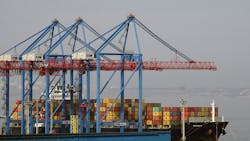Expect a new wave of supply chain headaches with Ukraine crisis, bevy of other issues
Editor's note: Reprinted with permission of IndustryWeek, an Endeavor Business Media publication.
Various U.S. cities and states are easing COVID-19 restrictions, even though a subtype of the Omicron variant, known as BA.2, is lurking around. As the world is anxious to recover its economy, a new wave of global supply chain disruptions is causing product shortages and high prices.
Geopolitical conflicts and the lingering pandemic are creating different supply chain disruptions, ranging from the interrupted supply of basic materials from Ukraine to factory and port closures in China. At the same time, congested port operations and labor contract negotiations in the United States are likely to exacerbate these disruptions.
Even before the Russian invasion of Ukraine in late February, the International Monetary Fund (IMF) downgraded its 2022 global growth forecast to 4.4% amid Omicron surge in January. Current and future shortages of basic materials can disrupt the production of many products around the world, resulting in shortages and high prices.
Since 2021, major international brands refused to use cotton from Xinjiang China for production due to suspected forced labor practices in Xinjiang. This boycott created an international cotton shortage. Besides cotton, the world’s wheat and corn supply will be reduced due the conflict between Russia and Ukraine. These two countries supply 29% of worldwide exports of wheat and 17% of worldwide exports of corn.
Also, there will be significant shortages of natural gas and noticeable crude oil shortages in many European countries should NATO countries decide to impose sanctions by blocking imports of crude oil and natural gas from Russia. In 2021, 40% of EU’s gas and over 25% of crude oil were imported from Russia, whereas 7% of U.S. crude oil was imported from Russia.
Semiconductor Disruption
Making things worse, Ukraine is a critical supplier of neon and argon used in chipmaking. Ukraine produces 70% of the world’s supply of neon. Neon is used in lithography, which is a crucial step in the chip production process. Argon is used in etching, which is needed for producing semiconductors. Besides Ukraine, Russia supplies 35% of the U.S.’s palladium, a rare metal that is used for semiconductor production.
The Russia invasion of Ukraine will disrupt semiconductor production in the United States and beyond. Finding alternative supplies of neon gas and palladium will also take time. Some suppliers are developing ways to recycle neon and other materials as a stopgap solution.
Ultimately, these material supply disruptions will prolong the shortages of many products, creating a perfect storm for escalating inflation worldwide.
Lockdowns in China
While supplies from Ukraine and Russia will be disrupted, China’s “Zero-COVID” policy extended the supply chain disruptions at various factories and ports. For instance, lockdowns at some factories and major port cities such as Shenzhen, Tianjin and Ningbo have disrupted the flows of goods from China to the U.S.
Because the Omicron variant is highly transmissible and new variants are likely to emerge, this strict policy will continue to cause supply chain disruptions. These disruptions in China will slow down the recovery of the U.S. economy. This is because the U.S. will continue to rely on products imported from China in the foreseeable future.
Case in point: Despite higher import tariffs imposed by the ongoing trade war against China, the U.S. trade deficit with China rose 25% in 2021 over a year earlier to $396.6 billion. The current inflation is partly caused by the fact that U.S. firms offset the trade-war-induced tariffs on products imported from China.
To curb inflation, peaceful solutions between Russia and Ukraine will certainly help, as will diplomatic negotiations between the U.S. and China.
Supply Chain Issues at Home
Other than geopolitical issues, there are domestic supply chain operations in the U.S. that need attention. The Biden Administration announced dozens of measures that the federal government can take to address to strengthen freight transportation and infrastructure. These measures can address some long-term issues, but short-term and near-term solutions are needed now.
The unprecedented port congestion in the West Coast appears to be easing in late February 2022. However, because some shippers diverted their West Coast traffic to the East Coast in late December, these ships are jamming various East Coast ports. In late February, there were 30 ships waiting for berths at the Port of Charleston in South Carolina. The number of ships arriving in East Coast ports has increased, but Omicron infections reduced lift operators at some East Coast ports by 10%, causing delay in unloading containers at these ports.
Besides port congestions, ports in the West Coast are likely to encounter labor disruptions during the upcoming contract negotiation. The International Longshore and Warehouse Union (ILWU) will be representing 22,400 dockworkers to negotiate the labor contract that expires in July 2022. This labor union will negotiate with 70 privately owned terminal operators at 29 West Coast ports.
Previous contract negotiations have been contentious, and union officials often oppose expanded use of automation. During the last contract negotiation that began in 2014, the negotiation talks dragged into 2015. Previous contract negotiations often led to severe labor disruptions and shipping delays. The 2022 contract negotiation process is likely to be a long, drawn-out war.
Restoring global supply chain operations takes time and effort, and there are no quick fixes.
Christopher S. Tang is a University Distinguished Professor and Edward W. Carter chair in business administration at the UCLA Anderson School of Management.



